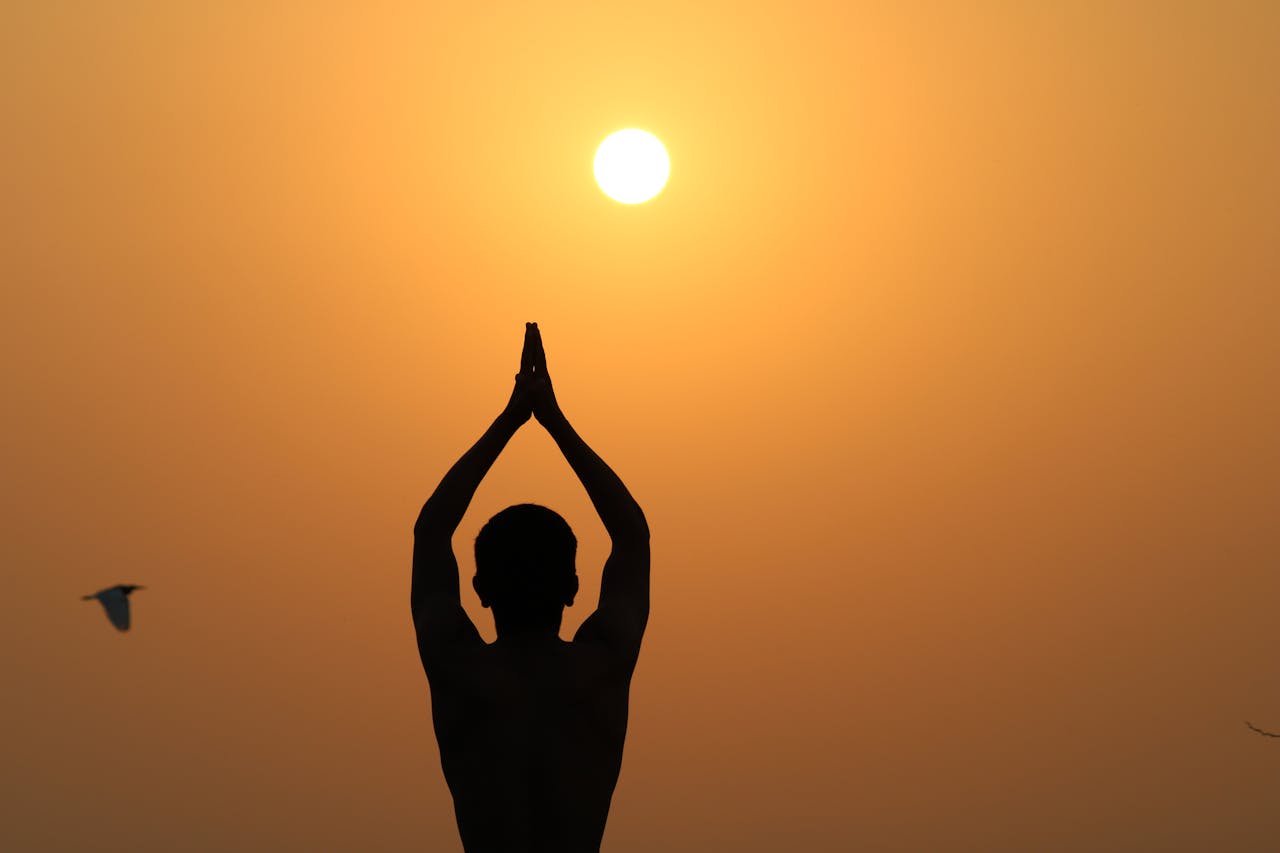
Table of Contents
Surya Namaskar B, or Sun Salutation B, is a flowing sequence of yoga postures commonly practiced in Ashtanga and Vinyasa yoga. It includes nine postures that strengthen and stretch the entire body, promoting deep breathing and focus.
Surya Namaskar B - The Second Sun Salutation in Yoga Practice
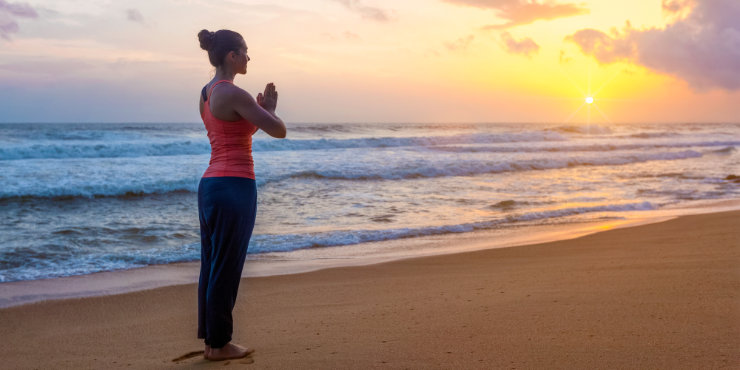 Surya Namaskar B, or Sun Salutation B, is a popular sequence of asanas in Ashtanga and Vinyasa-style yoga classes. The name comes from the Sanskrit words "Surya," meaning sun, and "Namaskar," meaning greeting or salutation. This sequence and its counterpart Surya Namaskar A are typically performed in three to five rounds at the start of a yoga practice to warm up the body and focus the mind.
Surya Namaskar B, or Sun Salutation B, is a popular sequence of asanas in Ashtanga and Vinyasa-style yoga classes. The name comes from the Sanskrit words "Surya," meaning sun, and "Namaskar," meaning greeting or salutation. This sequence and its counterpart Surya Namaskar A are typically performed in three to five rounds at the start of a yoga practice to warm up the body and focus the mind.
As a Vinyasa flow, sun salutations focus on moving from pose to pose rather than holding each pose. This combination of movement and breath in Surya Namaskar sequences helps to generate heat and focus the mind.
Ujjayi Pranayama in Yoga
Ujjayi breathing is a commonly practiced breathing technique in yoga, particularly in Ashtanga yoga. It involves narrowing the throat passage while breathing through the nose, producing a solid and resonant sound that serves as resistance for the respiratory muscles. This breathing technique generates additional heat within the body and is known as Ujjayi Pranayama.
An overview of the eighteen movements of Surya Namaskar B
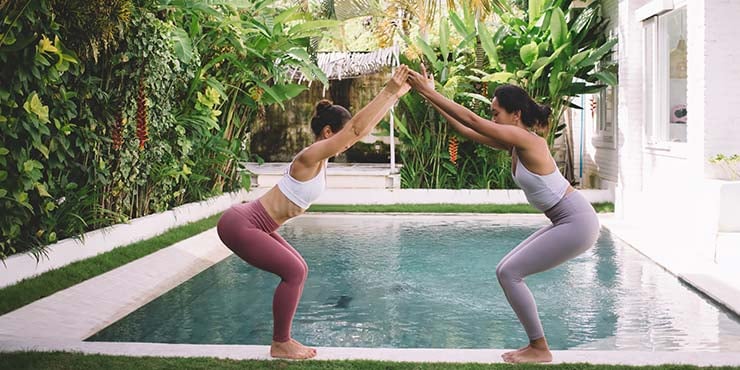 Begin in tadasana or mountain pose, with the feet hip distance apart and the hands by the sides. Ground into the feet and engage through the thighs with the pelvis tucked under. Following this, these are the eighteen postures of Surya Namaskar B, with their accompanying breath, that follows:
Begin in tadasana or mountain pose, with the feet hip distance apart and the hands by the sides. Ground into the feet and engage through the thighs with the pelvis tucked under. Following this, these are the eighteen postures of Surya Namaskar B, with their accompanying breath, that follows:
- Inhale-Utkatasana – Chair Pose
- Exhale-Uttanasana – Forward Fold
- Inhale-Ardha Uttanasana
- Exhale-Chaturanga Dandasana – Four-Limbed Staff
- Inhale-Urdhva Mukha Svanasana – Upward Facing Dog
- Exhale-Adho Mukha Svanasana – Downward Facing Dog
- Inhale-Virabhadrasana l – Warrior 1, right foot forwards
- Exhale-Chaturanga Dandasana
- Inhale-Urdhva Mukha Svanasana
- Exhale-Adho Mukha Svanasana
- Inhale-Virabhadrasana l – left foot forwards
- Exhale-Chaturanga Dandasana
- Inhale-Urdhva Mukha Svanasana
- Exhale-Adho Mukha Svanasana
- Inhale-Ardha Uttanasana
- Exhale-Uttanasana
- Inhale-Utkatasana
- Exhale-Tadasana
In ashtanga yoga poses, the main differences between Surya Namaskar A and B are the repetition of Chaturanga Dandasana (four-limbed staff pose), Urdhva Mukha Svanasana (upward dog), and adho mukha svanasana (downward facing dog). There are two other postures in sun salutations B - Utkatasana (chair pose) and Virabhadrasana 1 (warrior 1).
Benefits of Surya Namaskar B
Surya Namaskar B has profound benefits for the body, mind, and soul. Some of these benefits include:
- Provides a full body workout: Helps improve strength, flexibility, and balance.
- Boosts cardiovascular system health and circulation: Increases the heart rate and blood flow throughout the body.
- May reduce weight: Can reduce weight by improving metabolism and burning calories through the practice of a sequence of dynamic yoga postures.
- Improves digestion and metabolism: Massages and stimulates the digestive organs in the lower belly to relieve constipation.
- Calms the mind: Mindful breath and movement promote mental clarity and reduce stress and anxiety
- Strengthens muscles: Tones and strengthens the upper arms, legs, back, and abdominal muscles.
- Improves respiratory functioning: Increases lung capacity for a stronger respiratory system.
In addition to the mental and physical benefits, Surya Namaskar B offers numerous benefits to the chakras or energy centers of the body. The practice stimulates and balances the Manipura or Solar Plexus Chakra, which governs digestion, metabolism, and personal power. It also activates the Anahata or Heart Chakra, which is associated with compassion, love, and emotional balance.
Contraindications of Surya Namaskar B
While sun salutation B has substantial benefits, it is not for everyone. Those with the following conditions should avoid this yoga sequence:
- High blood pressure
- Heart problems or a history of heart disease
- Pregnancy, particularly after the first trimester
- Injuries or conditions affecting the wrists, shoulders, hips, or knees
- Recent abdominal surgery or hernia
- Vertigo or dizziness
- Migraines or frequent headaches
- Fatigue or exhaustion
- Fever or illness
It's essential to consult with a healthcare professional before beginning any new exercise routine, particularly if the practitioner has any of the above conditions or is unsure about Surya Namaskar B.
Utkatasana
Instead of just lifting the arms for the first and last movement as in sun salutation a, for the first movement in sun salutation B, one bends their knees and sinks to a half squat position with the arms raised above the head.
This posture is known as Utkatasana or chair pose. It’s also known as the fierce pose.
Staying balanced in utkatasana
To maintain balance while bending the knees, one should keep their weight slightly forward over their toes. Shifting the torso forward before bending the knees and then maintaining this position as the knees are bent, and the hips are back will help practitioners achieve this posture.
Uttanasana: A Standing Forward Bend
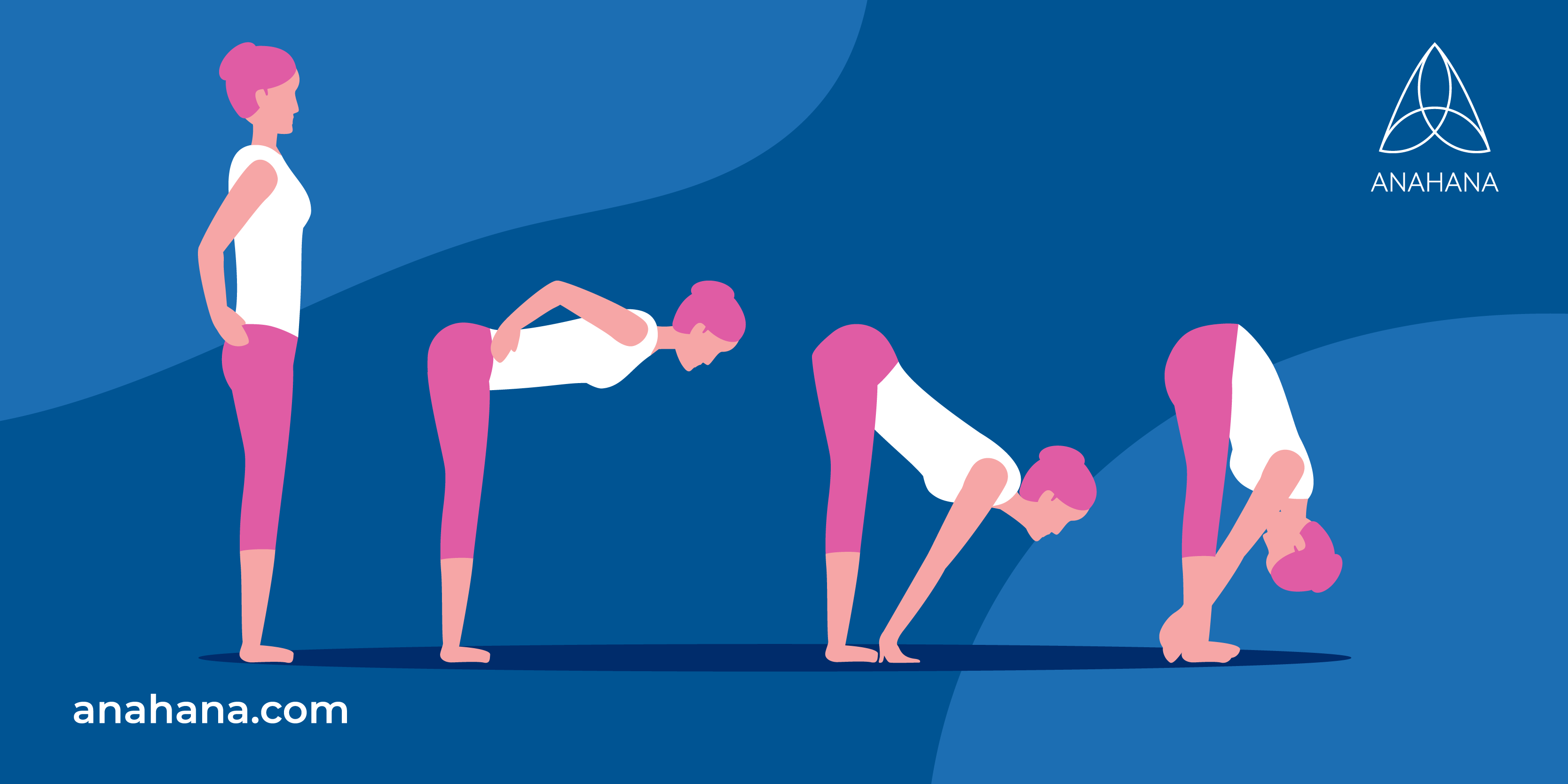 When moving into Uttanasana, one can move into a standing forward fold from Utkatasana and aim to touch the hands to the floor. Depending on their level of flexibility, they can choose to keep their palms flat on the ground while straightening their knees or lift their hands to straighten their knees if they cannot reach the floor.
When moving into Uttanasana, one can move into a standing forward fold from Utkatasana and aim to touch the hands to the floor. Depending on their level of flexibility, they can choose to keep their palms flat on the ground while straightening their knees or lift their hands to straighten their knees if they cannot reach the floor.
To improve forward-bending ability, one should focus on maintaining hip activation from Utkatasana while bending forward. Practitioners can repeat this action several times, bending and straightening the knees while keeping the hips activated. By doing so, flexibility and range of motion can gradually increase.
Ardha Uttanasana
After moving into Uttanasana, one can transition to Ardha Uttanasana (half-standing forward fold) by lifting the head, keeping the chin parallel, keeping the knees straight, and bending the hips forward. It is essential to maintain hip activation and use it to increase the forward tilt of the pelvis while bending the spine back. Ideally, one should keep their hands on the floor with straight knees while looking forward. If this is not in reach, the knees can bend before exhaling to get the palms flat on the ground or kept bent while looking forward.
Avoiding Neck Sprains
It is important to look forward slowly while reaching the chest forward and bending the thoracic spine (the back of the ribcage) backward to prevent neck sprains during yoga practice. One can ensure proper form by feeling the activation of the spinal erectors or lengthening the front of the abdomen. It can be helpful to practice bending the spine backward in isolation to become familiar with these sensations.
Chaturanga, Upward Dog and Downward Facing Dog
Exhale into Chaturanga Dandasana (Four-Limbed Staff Pose) from Ardha Uttanasana, inhale into Upward Dog, and exhale into Downward Facing Dog pose. Instead of holding this position, transition directly from Downward Facing Dog into the first side of Warrior 1.
Moving into Warrior 1
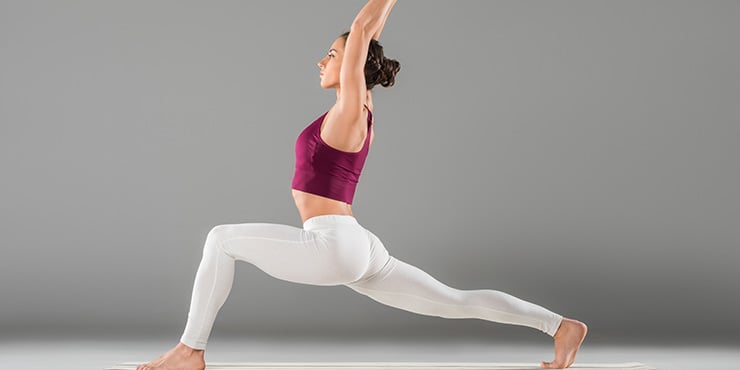 To begin Warrior 1, one should start on the right foot and inhale to move into the pose. From the Downward Facing Dog pose, shift the upper body forward so the shoulders are over the wrists. Next, lunge the right foot forward between the hands, bend the right knee, and turn the left foot out about 45 degrees with the heel on the ground.
To begin Warrior 1, one should start on the right foot and inhale to move into the pose. From the Downward Facing Dog pose, shift the upper body forward so the shoulders are over the wrists. Next, lunge the right foot forward between the hands, bend the right knee, and turn the left foot out about 45 degrees with the heel on the ground.
Keeping the left leg straight, adjust the front-to-back distance between the feet if necessary. Brace the front leg, lift the torso to an upright position, and reach the arms up over the head, touching the palms together while keeping the elbows straight. If touching the palms together is not possible, focus on reaching the arms up with straight elbows. Press firmly down through the heel to brace the foot without allowing the hips to lift.
Exiting Warrior 1
During the next exhale, one should bend forward and place the hands on the floor on either side of the right foot. After that, step forward with the right foot so it is next to the left foot and lift the left heel so that both knees point down. Then, bend the elbows to move into Chaturanga Dandasana. Repeat Upward and Downward Dog before stepping the left foot forward for the left side Warrior 1. Finally, repeat the same poses, including Chaturanga, Upward Facing Dog, and Downward Facing Dog.
Practicing the Transition into Warrior 1
If one is not used to stepping one foot forward from Downward Dog or has difficulty synchronizing this movement with their breath, they can practice shifting their upper body forward and lunging their foot forward in isolation. To keep the foot off the ground when swinging it forward, they can try lifting one arm for more room to swing their leg forward. For example, when stepping the right foot forward, one can shift their upper body to the left and lift their right arm to help pull the right leg forward. Practitioners can repeat this process when bringing the left leg forward for the left side Warrior 1.
Completing Surya Namaskar B with Downward Facing Dog
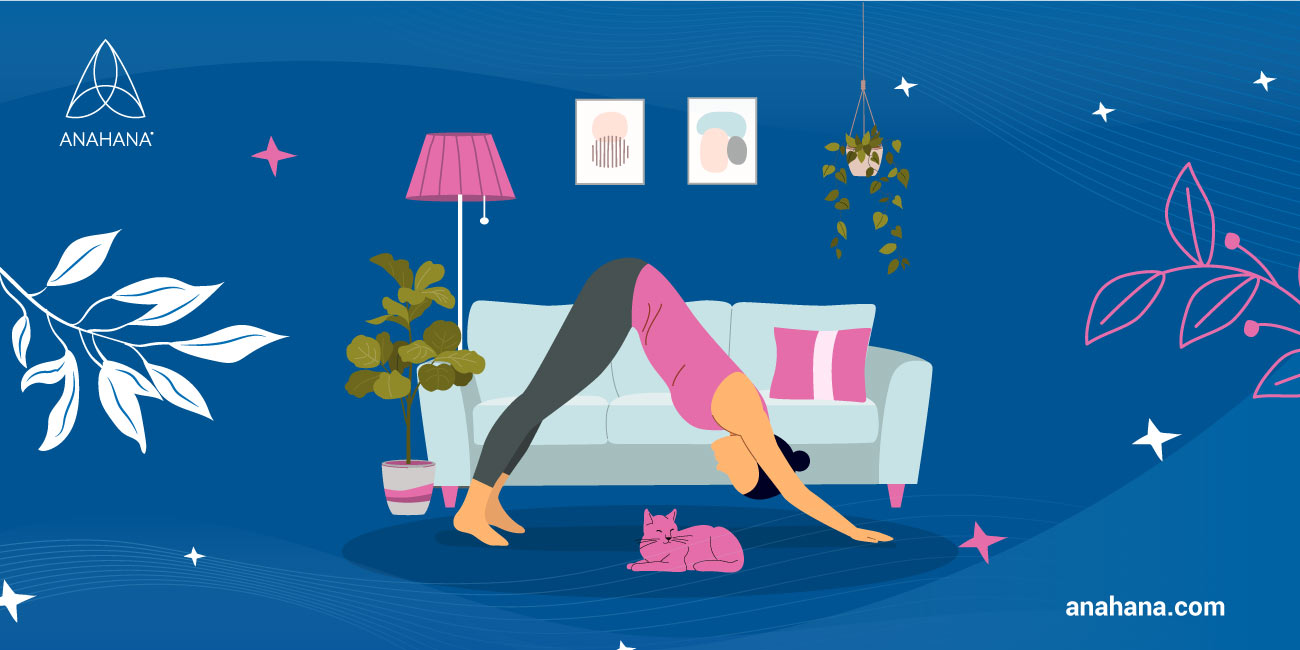 Upon finishing Surya Namaskar B, hold Adho Mukha Svanasana – Downward Facing Dog for a few breaths. Step or jump both feet forward between the hands while inhaling during the last exhale. Look ahead while inhaling Ardha Uttanasana and then exhale to Uttanasana.
Upon finishing Surya Namaskar B, hold Adho Mukha Svanasana – Downward Facing Dog for a few breaths. Step or jump both feet forward between the hands while inhaling during the last exhale. Look ahead while inhaling Ardha Uttanasana and then exhale to Uttanasana.
Take one breath and bend the knees slightly while raising the arms for the second repetition of Utkatasana. Exhale, straighten the knees and lower the arms to return to Tadasana.
Repeating Surya Namaskar B
The recommended number of repetitions for Surya Namaskar B can vary based on an individual's overall health and fitness level. Typically, it is best to start with a few rounds of repetition and gradually increase the number over time. Some practitioners may do five repetitions of Surya Namaskar B as a complete practice, while others may incorporate it into a more extended yoga session.
It is crucial to pay attention to your body and avoid overexerting yourself. If someone is new to yoga or has any health concerns, practitioners should consult a qualified yoga instructor before beginning any yoga practice.
References
What is Surya Namaskar? - Definition from Yogapedia
https://en.wikipedia.org/wiki/Sun_Salutation
https://www.masterclass.com/articles/sun-salutation-b-guide
Disclaimer
The contents of this article are provided for informational purposes only and are not intended to substitute for professional medical advice, diagnosis, or treatment. It is always recommended to consult with a qualified healthcare provider before making any health-related changes or if you have any questions or concerns about your health. Anahana is not liable for any errors, omissions, or consequences that may occur from using the information provided.
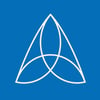
By: Anahana
The Anahana team of researchers, writers, topic experts, and computer scientists come together worldwide to create educational and practical wellbeing articles, courses, and technology. Experienced professionals in mental and physical health, meditation, yoga, pilates, and many other fields collaborate to make complex topics easy to understand.
